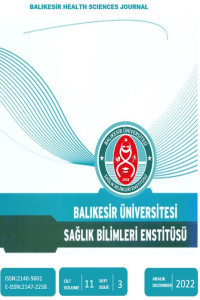Dioksin ve dioksin benzeri kimyasalların toksik etkileri
AMAÇ: Dioksin, organik klorlu (OK) bileşikler olarak bilinen, yüzlerce klorlu kimyasalın üretimi sırasında “ara” veya “yan ürün” olarak şekillenir. YÖNTEMLER: Çevrede son derece kalıcı özellikte olması nedeniyle hava, su ve toprağı önemli derecede kirleten bir işlem artığıdır.BULGULAR: Canlılar dioksinlere besin, su, solunum ve temas yolu ile maruz kalmaktadır. Fakat yağ dokuda birikme eğilimi gösteren dioksine uzun süre maruz kalınması, önemli sağlık sorunlarına yol açmaktadır. SONUÇ: Bu nedenle, çevre ve gıda örneklerinde dioksin ve benzeri kimyasalların varlığı ve düzeyinin belirlenmesi, canlı sağlığının korunması ve çevre kirliliğinin önlenmesinde çok önemlidir.
Anahtar Kelimeler:
Dioksin, dioksin ve benzeri kimyasallar, TCDD
___
- 1.Hoover RN. Dioxin dilemmas. J.Natl.Cancer Inst., 1999; 91 (9): 745-46.
- 2. Hu K, Bunce NJ. Metabolism of polychlorinated dibenzo-p-dioxins and related dioxin-like compounds. J.Toxicol.Environ.Health B. Crit.Rev., 1999; 2 (2): 183-210.
- 3. Bröker G, Bruckmann P, Gliwa H. Study of dioxin sources in North Rhine-Westphalia. Chemosphere, 1999; 38 (8): 1913-24.
- 4. NCASI. Summary of data reflective of pulp and paper industry progress in reducing the TCDD/TCDF content of effluent, pulps and waste-water sludges. National Council of Paper Industry for Air and Stream Improvement, New York, NY, June (1993).
- 5. Gibbs LM and the Citizens Clearing house for Hazardous Waste:Dying from Dioxin. A citizen’s guide to reclaiming our health and rebuilding democracy. South End Press, Boston, MA (1995)
- 6.Chopra M, Schrenk D. Dioxin toxicity, aryl hydrocarbon receptor signaling, and apoptosis-persistent pollutants affect programmed cell death. Crit.Rev.Toxicol. 2011; 41(4): 292-320.
- 7. Kaya S: Herbisidler, “Kaya S. ve ark. (eds): Veteriner hekimliğinde Toksikoloji, 1.baskı” kitabında s.272, Medisan Yayınevi, Ankara (1998).
- 8. HWN. New evidence that all landfills leak. Rachel’s Hazardous Waste News # 316, December 16. Available from Environmental Research Foundation, P.O Box 5036, Annapolis, MD 22403-7036, 410 / 263-1584 (1992).
- 9. Freeman RA, Hileman FD, Noble RW, Schroy J.M.:Experiments on themobility of 2, 3, 7, 8-tetrachlorodibenzo-p-dioxin at Times Beach. Insolving hazardous waste problems, Exner JH (ed): ACS Symposium Series, No.338 (1987).
- 10. Watanabe S, Kitamura K, Nagahashi M. Effects of dioxins on human health: A review. J.Epidemiol. 1999; 9 (1): 1-13.
- 11. Iida T, Hirakawa H, Matsueda T, Nagayama J, Nagata, T. Polychlorinated dibenzo-p-dioxins and related compounds: Correlations of levels in human tissues and in blood.Chemosphere, 1999a; 38 (12): 2767-74.
- 12. Jacob CJ, Lok C, Morley K, Powell DA.Government management of two media-facilitated crises involving dioxin contamination of food.Public Underst Sci. 2011; 20(2): 261-9.
- 13. Hites RA. Dioxins: an overview and history. Environ Sci Technol.2011; 45(1): 16-20.
- 14. Boffetta P, Mundt KA, Adami HO, Cole P, Mandel JS. TCDD and cancer: a critical review of epidemiologic studies. Crit.Rev.Toxicol. 2011; 41(7): 622-36.
- 15. Pirkle JL, Wolfe WH, Patterson DG. et al. Estimates of the half-lifeof 2, 3, 7, 8-TCDD in Vietnam veterans of Operation Ranch Hand.J.Toxicol.Environ.Health, 1989; 27: 165-171.
- 16. Iida T, Hirakawa H, Matsueda T, Takenaka S, Nagayama, J.Polychlorinated dibenzo-p-dioxins and related compounds in breast milk of Japanese primiparas and multiparas. Chemosphere,1999b; 38 (11): 2461-66.
- 17. Schumacher M, Domingo JL, Llobet JM, Kiviranta H, Vartiainen T. PCDD/F concentrations in milk of non occupationally exposed women living in Southern Catalonia, Spain. Chemosphere, 1999;38 (5): 995-1004.
- 18. Bowman RE, Schantz SL, Weerasinghe NCA, Gross ML Barsotti DA.Chronic dietary intake of 2, 3, 7, 8-tetrachlorodibenzo-p-dioxin (TCDD) at 5 or 25 parts per trillion in the monkey: TCDD kinetics and dose-effect estimate of reproductive toxicity. Chemosphere, 1989; 18 (1-6): 243-52.
- 19. Ulaszewska MM, Zuccato E, Davoli E. PCDD/Fs and dioxin-like PCBs in human milk and estimation of infants' daily intake: A review. Chemosphere, 2011; 83(6), 774-82.
- 20. Şanlı Y. Poliklorobifenillerle oluşan çevre ve besin kirlenmesi. Fırat Üniversitesi, Veteriner Fakültesi Dergisi, Cilt: VII, No. 1-2, ayrı basım (1982).
- ISSN: 2146-9601
- Yayın Aralığı: Yılda 3 Sayı
- Başlangıç: 2012
- Yayıncı: Balıkesir Üniversitesi
Sayıdaki Diğer Makaleler
Karaciğer Transplantasyonu Sonrası Hastaların Yaşadığı Sorunlar ve Hemşirelik Girişimleri
Neziha KARABULUT, Yeşim YAMAN AKTAŞ
Çocuklarda adenotonsillektomiye Güncel Yaklaşım
Mustafa KAYMAKÇI, Selçuk YAZICI
Ankilozan Spondilitli Olguda Anestezi Uygulaması
Özlem SAĞIR, Sabri ÖZASLAN, Yücel MERİÇ, İsmail ARSLAN, Ahmet KÖROĞLU
Dioksin ve dioksin benzeri kimyasalların toksik etkileri
Şahver Ege HİŞMİOĞULLARI, Adnan Adil HİŞMİOĞULLARI, Tünay KONTAŞ AŞKAR
